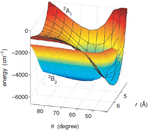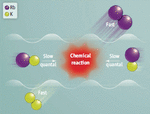
Reactions of ultracold alkali metal dimers
29 June 2010
The production and properties of polar alkali metal dimers is at the heart of CoPoMol and QuDipMol projects. Once produced, some of these molecules can react to form pairs of non-polar dimers, while others cannot. Until recently, there was concern about the possibility of another type of reaction, to form an atom and a molecular trimer. Now, CoPoMol scientists have shown that none of the alkali metal dimers in their ground states are unstable with respect to trimer formation. This means that some species, namely NaK, NaRb, NaCs, KCs and RbCs, will be stable towards all possible 2-body reactive processes. Read more...

Ultracold molecules in an optical lattice
25 March 2010
Researchers from EuroQUAM and EuroQUASAR lead by Prof. Hanns-Christoph Naegerl at Innsbruck University succeeded in producing ultracold molecules trapped in an optical lattice and published the results in Nature Physics. The molecular quantum gas is prepared in several steps. The starting point is a Bose-Einsten condensate of Cesium atoms which is loaded into an optical lattice formed by laser beams. The lattice parameters are then tuned to achieve a setting where most of the sites are occupied by two atoms which are then associated into weakly bound molecules via the Feshbach resonance. A four photon process is then used to bring the molecules to the vibrational and rotational ground state. The work opens prospects for the realisation of Bose-Einstein condensation of ground-state molecules and could be generalised to polar heteronuclear molecules in the future.

Cold Chemistry Case
A perspective on ultracold chemistry by Prof. Jeremy Hutson appeared in Science Magazine describing recent developements in the contol of chemical reactions at ultra low temperatures. The article has been extensively quoted in the scientific press including Scientific American, American Chemical Society News and Physics World.
Prof. Rudolf Grimm Austrian Scientists of 2009
25 March 2010
Professor Rudolf Grimm, project leader of FerMix, has been awarded the title of “Austrian Scientist of the Year 2009” by the Austrian Club of Education and Science Journalists for his achievements in promoting the knowledge and understanding of basic sciences among the general public. Professor Grimm has been working for the last 10 years at the University of Innsbruck were his group has established itself as one of the world leading teams in the field of quantum physics. He studied physics in Hannover and obtained his PhD at the ETH in Zurich and then went on to the Institute of Spectroscopy in Troitsk near Moscow for half a year. He worked in Heidelberg at the Max Planck Institute for Nuclear Physics before joining the University of Innsbruck, where he is now Scientific Director of the Institute of Quantum Optics and Quantum Information.
He is currently working on Bose-Einstein condensation of atoms and molecules and fermionic quantum gases. In 2002 his group demonstrated the first Bose-Einstein condensate of Cesium in the world. A year later they obtained the first Bose-Einstein condensate of molecules followed by the realization of a Fermionic condensate in 2004. In 2006 the team demonstrated experimentally the so called Efimov effect which was forseen 35 yearg ago by the Russian scientist. Today his group is able to produce ultracold quantum gases of more complex molecules. For his scientific achievements prof. Grimm has been awared several other prestigious national and internationals awards.
Sympathetic Cooling of NH Molecules
16 November 2009
For the first time a molecular system in which sympathetic cooling has good prospects of success is presented by the CoPoMol team at Durham University. As previously reported, for most candidate systems, interaction potentials have deep wells and strong anisotropy causing the inelastic collisions to prevent efficient sympathetic cooling. Prof. Hutson and co-workers demonstrate that in the case of the Mg+NH system the ratio of elastic to inelastic cross sections is high enough to allow symphatetic cooling over a wide range of collision energies and magnetic fields. The results have been published in Physical Review Letters, 103, 183201 (2009).



